#rockposters
Text

I drew this flyer for Radio Weekend, a Seattle power pop band that my friend Josh is in. My dog is the model. (@peppersagoodpepper on Instagram!)
#drawing#illustration#rockposters#rockflyers#seattlemusic#thepopcycle#hotrollersband#dogportraits#artists on tumblr#radioweekend
0 notes
Photo

GIG POSTER GUACHO
#gigposters#gigposter#gigposterart#gigposterdesign#posters#posterdesign#rockposters#rockposterart#ilustración#Illustration#posterillustration#matiasguti
0 notes
Photo

Reposted from @ckoehlerart Life is weird isn't it? One day you're an overly emotional twelve year old obsessively playing Siamese Dream on a discman drawing pictures inspired by Smashing Pumpkins, the next you're obsessively listening to Siamese Dream on Spotify drawing pictures FOR Smashing Pumpkins. I am so happy to share this poster for tonight's show in Houston. It was a labor of love for one of my favorite bands and one of my most personal pieces (and I got to really dig in and have fun with the calligraphy). This year has been bananas, I don't even know what to say at this point other than I am grateful and humbled. Eternal thanks to @collectionzz and @smashingpumpkins for having me on board. I hope you dig it! I should also have prints at some point, so stay tuned if you'd like one... #smashingpumpkins #rockposters #rockposter #houston (at Houston Texas) https://www.instagram.com/p/CjRpqiYjpXs/?igshid=NGJjMDIxMWI=
0 notes
Photo

new single: Calice (pronounced "callous") drops on all major platforms November 10th pre-save & other such links coming soon if you're in the Lafayette area, we'll be playing a few times in celebration of its release in preparation for the new album we're wrapping up as well - first of those times being THIS Saturday (October 8) at Artmosphere with several CHOICE art vendors & food from our dear boy @saucaybawbbq - free to get in! artwork by @lostintimedesigns poster layout by @magicjackm keep it spooky, baby #artrock #postpunk #punkrock #postpunk #newrock2022 #rockposters #rockmusicposter #psychrock #punkrockposter #calice #lafayettemusic #lafayettelinks #links2022 #thelinksband #thelinksmusic (at Lafayette, Louisiana) https://www.instagram.com/p/CjQbUV1vNvF/?igshid=NGJjMDIxMWI=
#artrock#postpunk#punkrock#newrock2022#rockposters#rockmusicposter#psychrock#punkrockposter#calice#lafayettemusic#lafayettelinks#links2022#thelinksband#thelinksmusic
1 note
·
View note
Photo

There must be a way to repost this from their page but I’m not a social media kingpin. Go to here if you want some deals on some cool posters and vinyl. My first poster is in the upper left corner! #dinealonerecords #dinealonestore #gigart #rockposters (at Dine Alone Records) https://www.instagram.com/p/CiyI08Uudj6/?igshid=NGJjMDIxMWI=
0 notes
Text
radiation is fucking crazy like you stared at this rock for too long? it put a curse on you. you will die in 6 months
732 notes
·
View notes
Text
Hey there! I'm Lucy, your local sword lesbian. I'm trans, poly, and extremely flirty. Married to @jadedkitteh, dating @ginny-erinschild!
I love to ramble about things, and I love to hear people ramble about things, so if you want to hear me talk or talk yourself, pop into my dms~!
I post a lot of varying things, mostly reblogs; 99% untagged except for the rare #swordposting. Ton of horny stuff, so if you're not 18 or older, probably stop here.
I very frequently keep an eye on my notes and follow people who reblog from me; if you're leaving lots of tags or reblogging lots of stuff.... I'll notice. 💖 Might even say hi....~
My interests
I'm big into games, queer shit, I also stream sometimes (twitch.tv/LucyValeheart), books, action and fighting and fantasy in all forms... Swords in particular, which hopefully is obvious given my title. Check my #swordposting tag for more about the ones I own!
I also own lots of rocks, so #rockposting may have one or two posts in it soon.... Who knows :3
Horny shit
Im into a lot. Like, a lot. And finally I've managed to fill out a kink chart I found online. It doesn't cover everything, but it hopefully paints a decent picture 💖

I'm about 90% submissive, but it's covered by my brattiness, and there's always that sneaky 10% domme in me....~
.....though admittedly, lately I've swung from 90 to 60, then back to 95, and it's really dependent on the day.... One of these days I'll figure it out!
I won't likely be posting any photos publically (shyness, self-dislike, security, etc) but I'm very happy to show people I'm talking to privately. If you want to skip tumblr messenger, my discord is lucyvaleheart; leaving that nice and settled deep under the cut so you have to work for it ;)
Just make sure your first message or so includes who you are on tumblr, or I may not keep you added for long <3 and do bear in mind that I am a lesbian, so I likely won't do any flirting with men :p
But don't be too intimidated~! Save that for a little further in this intro when you find out how tall and strong I am ❤️ I'm very open to chatting, and pretty good at keeping a conversation going c: try sending a simple "Hey" and I'll get things going from there!
About me
I'm trans as my header says, she/her, it/it's, 6'0" and about 350 pounds of muscle. I am obscenely strong. Yes, I can probably lift you. Yes, even you. Yes, I'm sure. I'm certainly going to try. 💖
A testimonial:

Here's a gif of my favorite katana and a video of my sparkliest rock for getting through all that text.

90 notes
·
View notes
Text
ever since my geology kick i keep trying to analyze rock formations in video games like they are real. This is of course an exercise in futility because I doubt environment designers think about the implications of the rock formations on the local geography & past and present volcanic activity...erosion...etc. Now I want to see a real geologist analyze video game rocks for accuracy.
#enzel.txt#rockposting?#I'm sure there are a few environment artists that are rock nerds that go hogwild#the rocks in elden ring are rly good. I stare at them a lot#how realistic they are idk but they look pretty damn cool
53 notes
·
View notes
Text
Let's Talk Pyrite Disease
Okay. Pyrite is amazing. Pyrite, or fool’s gold, has a simple formula (FeS2), forms beautiful cubes, and has all sorts of cool features. I'll talk later about how iron minerals can move and change and how they're related to theories about cells, but first, let's talk about Pyrite disease.

Image ID: Several pyritized ammonite shells in various stages of decay. They all have a light-grey color and a velvety appearance. There are a few in the center that are severely decayed and appear to be just a pile of dark grey and yellow dust, with a similar appearance to mold. One ammonite in the top-center is a more gold-brown color and has cube-shaped pyrite crystals on it. End ID.
[Image by https://twitter.com/MSidKelly/status/667548523475288064]
TLDR: Pyrite disease is a form of rust that impacts pyrite. It produces iron oxides, sulfuric acid, and sulfur dioxide, damaging mineral specimens, fossils, and storage materials. It causes expansion and acid damage that cracks and erodes specimens.
oh and @simple-potato-farmer, @team-clockers, @edthefatmagicturtle, y’all expressed interest in this so here you go! warning: it’s 10 pages long
How Can Fossil Come in Contact with Pyrite?
Pyrite is the most abundant sulfide mineral. Pyrite is found in quartz veins, coal mines, sedimentary rock, metamorphic rock, and in fossils as a replacement mineral. Pyrite forms in anoxic environments, which makes it a good environmental indicator. It also means that pyrite is found in association with many deep ocean fossils.
Fossils can be replaced by pyrite. This happens in a process called pyritization, a form of replacement diagenesis where the original material of the organism (in some cases, even soft parts) is replaced by pyrite. For instance, due to the anoxic and high-sulfide concentration in the deep ocean, calcite shells may be replaced by iron pyrite. This is aided by the presence of sulfur-reducing bacteria that facilitate the creation of iron sulfides, and therefore facilitate the precipitation of pyrite during decay(1) as sulfides are produced by the decaying organism(2). In a unique case, high microbial activity led to documentation of pyrite formation on the shells of living mollusks(3). This process leads to beautiful pyritized fossils that look like metal casts but actually are the fossil completely replaced by pyrite.

Image ID: An ammonite cut in half to show pyritization. The entire ammonite appears metallic gold, and the internal cavities contain fine drusy pyrite crystals. End ID.
[Image by: Replacement/Recrystallization (petrifiedwoodmuseum.org)]
Not all fossils end up beautifully pyritized, and not all pyritized fossils stay that way. Pyrite disease, also called pyrite oxidation, pyrite rot, or pyrite decay, is a form of rust. Millions of years of history, only to be destroyed by poor archiving, humidity, and pyrite decay.
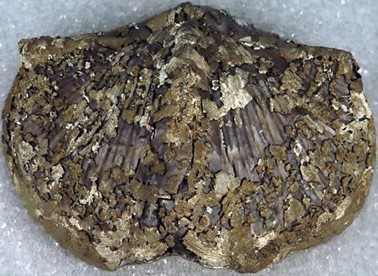
Image ID: A brachiopod specimen with pyrite replacement and a patchy outer coating of pyrite. Unlike the ammonite, the pyrite has grown over the shell of this brachiopod in addition to replacing the original structure. End ID.
[Image by: jsjgeology.net/Replacement.htm]
What does Pyrite Disease Do?
Since pyrite is formed in anoxic conditions, most pyritized specimens remain stable for a long time. The reason we observe so much pyrite decay in museum settings and other fossil collections is because the specimens have been removed from the rock and sediment that were limiting their exposure to oxygen. Pyrite decay can occur with or without water, but when pyrite oxidizes in humid air, it reacts with both oxygen and water. This creates not only iron oxide ‘rust’, but also iron sulfate, sulfuric acid, and sulfur dioxide gas4 (corrosive and toxic materials)(1). This chemical reaction eventually destroys the specimen through a combination of factors. The sulfuric acid is corrosive and damages the specimen. Oxidized pyrite is unstable and may crumble over time. There is also another damaging factor: the risks of pyrite replacement and iron sulfate production.
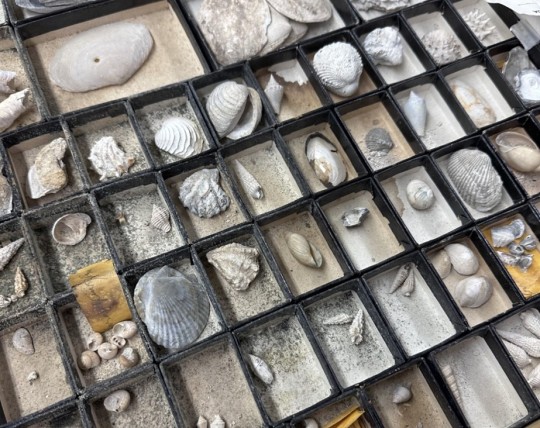
Image ID: A tray of mollusk fossils, each with separate boxes, with evidence of pyrite decay. There is dark grey dust in the bottom of most boxes, and a line of what appears to be water damage across the boxes. The apparent water damage is the result of the sulfuric acid produced. It has also discolored fossils and their labels. End ID. [Image by me]
Pyrite disease is a progressive process that affects fossils over time. Many pyritized specimens may last for years in perfect condition, while many others progressively decay from undetected pyrite disease. The reason that pyrite replacement is notorious for decay has to do with the crystal structure of pyrite. The famous cuboid structure of pyrite crystals is the most stable form of pyrite(4) since the compact form does not easily absorb moisture. Pyrite may occur in a compact, crystalline, stable form or a porous microcrystalline form that is unstable. Certain formations produce more stable pyrite with fewer impurities, but certain fossils are also more susceptible to unstable forms of pyrite. Marcasite is a less common dimorph of pyrite that is more unstable(5). Ammonites, especially those from the Charmoth clays, are notorious for pyrite decay while South American specimens and Yorkshire coast fossils are much more stable(2). The iron sulfate that is produced by the oxidation process is considered an efflorescent mineral(5), a term that means “flowering.” This is because this material has a higher molar volume (the ratio of the volume occupied by a certain amount of a substance) than iron pyrite and wedges the specimen apart as it expands past the constraints of the original crystal structure(5).
Unfortunately, the creation of efflorescent minerals, including other hydrous sulfate minerals, creates a feedback loop. These materials produce acids and provide water that causes the pyrite to further decay, producing more Fe3+ and more efflorescent materials, which feed the cycle of oxidation(5).

Image ID: Two images of the same pyrite disk, taken two years apart. In the left image, the disk has a few cracks and white discoloration in the center, with a yellow outline around the discoloration from sulfur. In the right image, the disk is shown two years later, cracked into four large pieces. The discoloration now extends almost to the edges of the disk, with a much larger yellow margin. End ID.
[Image by Ed Clopton, General: Need 'Pyrite Disease' Photos (mindat.org)]
(For an interesting, related topic – pyrite decay is a risk in coal mining for a multitude of reasons, including the increase of pulmonary and respiratory disease after pyrite inhalation, the risk of silicosis, and the risk of spontaneous combustion caused by the exothermic reaction involved in the decay of high-sulfide deposits.)
What Does Pyrite Disease Look Like?
Pyrite disease may appear grey, greenish, black, red-orange, white, or sulfur yellow. A redder color indicates rust from other iron minerals other than pyrite. Since pyrite contains sulfur and pyrite oxidation produces sulfuric acid, it may have the rotten-egg smell often associated with sulfur. A metallic-iron smell may also be present. Inhaling the result of pyrite decay can be hazardous (in my experience, it caused migraines even when I double-masked before entering the room due to the severity of the condition of our collections. In most cases it is much less of a concern). If pyrite disease is found, wear gloves and masks and try to disturb the dust as little as possible. Remember that pyrite disease is worse in humid conditions, and these same conditions may encourage the growth of mold. The early stages of pyrite disease may appear as spots of discoloration on a fossil, a slightly duller appearance, additional crystallization, or cracking. Often, the first noticeable sign that is clearly identifiable is dust in the bottom of the box the specimen is in. In these early stages, the severity of the pyrite decay may not be detected until the specimen is moved or handled, and subsequently begins to crumble or leaves dust and a metallic smell on your hands. Later stages appear like mold and may have a fuzzy, cloud-like appearance. If you handle a specimen with pyrite disease, take care to wash your hands and dry them well before handling any other specimens, and check the container or the contaminated specimens and those that surround it so that they can be replaced if needed. In the worst stages of pyrite decay, what is left is not a fossil that may crumble if handled, but a pile of dust. Pyrite disease can affect vertebrate fossils, invertebrate fossils, botanical specimens, mineral specimens with pyrite, and the containers and shelving used.
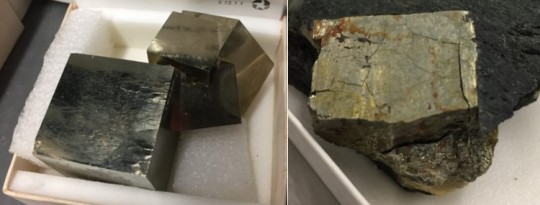
Image ID: Two images of cubic pyrite crystals. Left: Four cubic pyrite crystals growing into each other, they are a solid metallic gold color with few visible imperfections. Right: a cubic pyrite crystal in a dark matric. This piece is affected by pyrite decay, and the cubic shape is no longer perfect due to cracks in the specimen. It has orange and yellow sections that appear like water stains due to the sulfuric acid produced by pyrite oxidation. End ID.
[Image by Pyrite Disease - Canadian Museum of Nature]
Why Is It A “Disease?��
If the damage to the fossils themselves was not bad enough, consider another factor: it’s often called pyrite disease, instead of pyrite oxidation, for a reason. That reason is that pyrite disease spreads and progresses over time. Historically it was thought that this was the result of a bacterial component, and it was even recommended to treat fossils with antibacterial ointments(5). While bioleaching of pyrite is studied, bacterial theories are no longer supported. The spread of pyrite disease is due to the spreading of acid and the flaking of iron sulfates that may trigger decay on other specimens that already contain pyrite. Although this process is not contagious due to bacteria, it is still an irreversible process that causes fossils to crumble to dust and is, to an extent, a contagious process. The sulfuric acid and sulfur dioxide created in pyrite oxidation can damage the containers and fossils near the contaminated specimen.
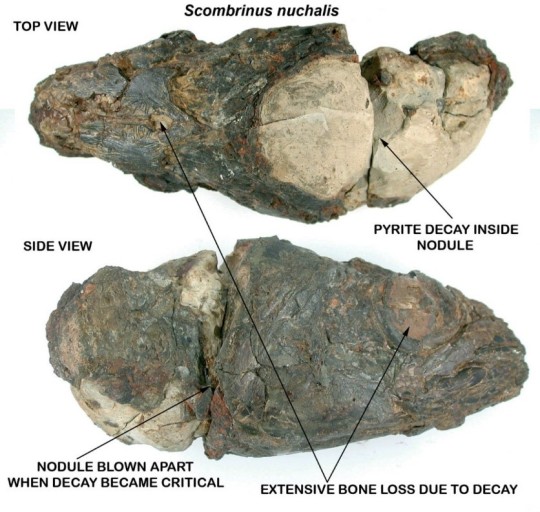
Image ID: An annotated example of a fish skull preserved in a nodule, which decayed and broke due to pyrite disease. There is a top view (top) and a side view (bottom, fish facing right). There are labels pointing to the top of the skull and to the eye socket showing cavities and red-orange rust labeled “extensive bone loss due to decay.” A white section of the nodule that is split and crumbled is labeled “pyrite decay inside nodule.” The side shows extensive decay to both the fossil and nodule, labeled “nodule blown apart when decay became critical.” End ID.
[Image by Trouble with pyrite – Deposits Mag]
One of the reasons that it is considered a disease is the progressive nature of pyrite decay, which visibly worsens over time. Another reason is the way that sulfuric acid seems to spread and contaminate even the container that the fossil is held in, leaving damage marks on the fossil and its labels. Another factor is the fact that the products of pyrite oxidation expand, appearing like mold or growths that further damage the fossil. The expansion of these oxidation products is one of the most damaging aspects of pyrite disease, as the instability in the crystal structure of the specimen causes cracking and flaking. This is because pyrite oxidation causes the conversion of iron pyrite (FeS2), an iron sulfide mineral that has a cubic crystal structure, to iron sulfate (FeSO4), which has an orthorhombic crystal structure. Not only does this cause the specimens to crack and crumble, but the cracking of the specimen causes flakes of pyrite to break off and spread. These flakes may land on other specimens, spreading the contamination of pyrite decay to other fossils that were previously stable. In many cases, museums must face difficult decisions to remove scientifically valuable specimens, or even portions of specimens, to prevent further spread of pyrite disease.

Image ID: Left: The crystal structure of iron pyrite. Right: The crystal structure of iron sulfate. End ID.
[Images by: mp-226: FeS2 (Cubic, Pa-3, 205) (materialsproject.org)]
How Can Pyrite Disease Be Managed?
Now, I’ve said that pyrite disease is unreversible. But can it be stopped from progressing once it contaminates a specimen? The simple answer is no. The more complicated answer follows:
Several factors that contribute to pyrite disease: temperature, humidity, oxygen levels, pH, exposure, crystal structure, and bacteria(3). Some factors, such as bacteria and pH, require specific conditions that are uncommon (Thiobacillus bacteria are present over 95% humidity(3) and pH is often affected by the decay process and the methods used to manage it). Other factors are closely linked (e.g., temperature and humidity).
Pyrite disease is most closely linked to humidity and high oxygen conditions. The best way to stop pyrite disease is prevention. Most museums use some form of climate control to preserve their specimens, but the issue here is that vertebrate fossils (bones) have a moderate recommended relative humidity level (~45-55%) in order to avoid cracking or warping6, while the recommended humidity level to prevent pyrite disease is 30%(7) (although below 50% is also stated by some sources(2,8)). In contrast, humidity above 60% is known to accelerate the decay, even to the point that decay begins within a few days of exposure(3, 2). This low humidity level is not always possible, especially for public display, although it is used in some invertebrate collections. Using humidity and oxygen scavengers (e.g., silica gel packets) when collecting can reduce the exposure of specimens to these factors. Using humidity and oxygen barriers when storing specimens can prevent pyrite disease(3). Contained storage of an already contaminated specimen may trap moisture with the specimen. Although, I would say it is better to have an isolated specimen that decayed than have an open specimen contaminate others.

Image ID: The unpolished appearance of a pyritized ammonite. The ammonite is held in front of a rocky area. It is a dull grey color with a matte appearance. It has lumps of rounded pyrite surrounding it. End ID.
[Image by Martin Curtis, Pyrite Decay in Fossil Collections – ZOIC PalaeoTech Limited (zoicpaleotech.com)]
Since the damage from pyrite disease is exacerbated by sulfuric acid, one of the other prevention methods used relies on acid neutralization(5), although this is less common. Currently, the use of humidity and oxygen buffers is the most common method, but some groups rely on extensive testing of specimens to determine which have unstable forms of pyrite incorporated into the fossil or matrix before acting. Another preventative method is removing salt (which may speed up the decomposition) and removing any matrix that may contain pyrite or trap moisture (e.g., clays)(5). Washing specimens to remove salts or matrix remains could damage specimens that are already unstable or could cause damaging moisture exposure (although this could be avoided by washing with alcohol).
Many studies have attempted to find effective ways to stop, reverse, or prevent pyrite decay. From acid treatments to preemptively coating specimens in resin, these tested methods were often damaging to the specimens, especially over the long term. However, were they damaging enough to be worse than pyrite disease? Not necessarily, but a combination of the damage done, the cost, the time investment, and the ineffectiveness of these treatments means that prevention is still the only reliable method for pyrite disease.
Coating specimens in resins and varnishes may provide a buffering effect, but the resin only slows oxidation, it does not stop it. This becomes an issue when the vanishes cannot be removed, and the specimen cannot be accessed for other treatment methods(2). Varnishes may delay the effects, but they have effects of their own, are usually not moisture-proof, and may yellow and crack over time. Coating with resin or embedding the fossil in resin creates the risk of an explosion as the oxidative reaction builds heat and pressure. Some museums coat their fossils in plastic glues (such as Paraloid B-67 or B-72), these glues are reversible, and B-67 is hydrophobic, unlike most resins.
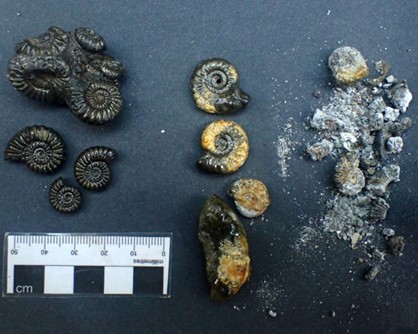
Image ID: Examples of varnished ammonite specimens, showing progressive stages of pyrite disease as the varnish aged and cracked. Left: Complete pyritized specimens with no signs of decay and a glossy finish from the varnish. Center: Pryitized specimens with patches of yellow-orange decay in sections where the varnish cracked. Right: specimens reduced to dark grey and white dust. End ID.
[Image by Chris Andrew, Pyrite Decay in Fossil Collections – ZOIC PalaeoTech Limited (zoicpaleotech.com)]
There are two “cures” to pyrite decay. However, these do not cure pyrite decay in the sense that they reverse it. Instead, these are methods to neutralize the products of pyrite disease to prevent further harm to the specimens. These two methods involve the use of ammonium gas or ethanolamine thioglycolate to remove pyrite byproducts (ammonia converts the iron sulfate to iron oxide(8)) and neutralize any generated sulfuric acid(2). Both methods are intensive, potentially hazardous, and relatively expensive. As a ‘cure,’ they are effective at temporarily halting the progression of pyrite disease, but not preventing it or reversing it. These treatments have been proven to be ineffective at preventing pyrite decay without the use of controlled microclimate (oxygen and humidity exposure)(3).
References:
1 Replacement/Recrystallization (petrifiedwoodmuseum.org)
2 Pyrite Decay in Fossil Collections – ZOIC PalaeoTech Limited (zoicpaleotech.com)
3Minerals | Free Full-Text | Pyrite Decay of Large Fossils: The Case Study of the Hall of Palms in Padova, Italy (mdpi.com)
4Pyrite Disease - Canadian Museum of Nature
5Pyrite disease (palaeo-electronica.org)
6Shells Eggs Bone and Related Materials 160229 (welshmuseumsfederation.org)
7PowerPoint Presentation (vertpaleo.org)
8Trouble with pyrite – Deposits Mag
#vpoc writes#rockposting#vpoc yells#pyrite disease#pyrite oxidation#vpoc has cool rocks#other cool rocks#long post#paleontology#geology
61 notes
·
View notes
Text
rock shelf rock shelf Rock Shelf Rock Shelf ROCK SHELF ROCK SHELF ROCK SHELF ROCK SHELF
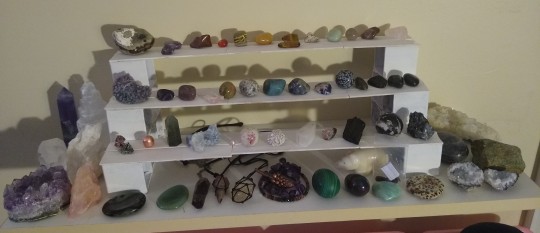
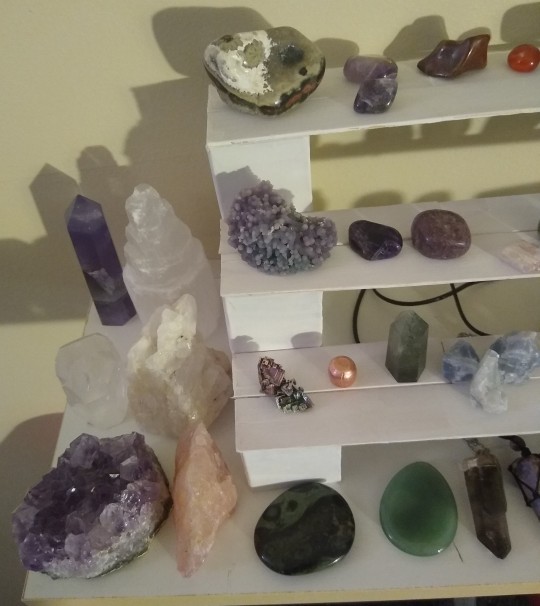


35 notes
·
View notes
Text


i’m going to cry… rock’s child inherits the most feral abnormal messed up dna of any child ever and still ends up being the most well-adjusted one (rock’s nurture overcoming his and his child’s nature)
(this is from this rrreddit post. if you’re wondering why molly and rock’s kids are low energy…. i have no idea why 規則正しい was translated “energy” either because it‘s more like “orderly”…? i’m not native in jp so idk)
#rock is not a man who was housebroken prior to marriage#he simply can not be a creature who was raised by human parents during his formative years#he literally threw records like frisbees and broke tei’s most valuable souvenirs#tei and lou must have spent a fortune rock-proofing the inn#they had to replace the door when making it into a guest room for van… h-holy fuck#he likes FODDER. man belongs in the barn (he agrees. he thinks it’s a bar/hangout spot after marriage)#new evidence for adoption theory: the fact that this level of Feral Man could only come from a tarzan scenario#our son in anwl literally barked. he said “arf!”#every single morning rock asks if he’s a good boy (did i train him between ch 1 and 2)#ok honey if you finish your chores for today you can have some fodder. as a treat#i also love that his dna apparently overwrites yours. like the other kids could be a blend of you and your spouse#but rock’s is just a minmaxed gremlin#sos awl#rock collection#Real Cordylia Tagblogging Hours™#sorry for rockposting at 3 am i promise i’m normal (high energy)#rock tumbling (sos)
25 notes
·
View notes
Photo

Reposted from @fredpaints23 Beyond honored to be asked to contribute art for the @smashingpumpkins club shows this week. @metrochicago and @irvingplaza with area specific details! Having people I respect show me the trust to create work for them is the best feeling. @wpccodex @jjjschroeder @jamesihaofficial @chamberdrums @jackbates_music @katiecoleofficial . . . . #smashingpumpkins #thesmashingpumpkins #billycorgan #jamesiha #jeffschroeder #jimmychamberlin #rockposters #rockposterart #gothic #love #atum #madamezuzus #chicago #picasso #newyork #wizardofoz #holygrail (at Irving Plaza) https://www.instagram.com/p/Ci3hkGsp2LA/?igshid=NGJjMDIxMWI=
#smashingpumpkins#thesmashingpumpkins#billycorgan#jamesiha#jeffschroeder#jimmychamberlin#rockposters#rockposterart#gothic#love#atum#madamezuzus#chicago#picasso#newyork#wizardofoz#holygrail
0 notes
Text
idc if this is a hot take but I think crystals do have healing properties because I see one, and then I'm happy I saw a cool rock.
12 notes
·
View notes
Text
Mark Knopfler really put his whole pussy in the opening riff to Money for Nothing thanks king
3 notes
·
View notes
Photo

Illustration #illustration #poster #prints #rockposter https://www.instagram.com/p/Co3W41uSWnE/?igshid=NGJjMDIxMWI=
19 notes
·
View notes
Text
Today I looked at the pile of rocks in my truck that are covered with dirt and shit and held them up to the sun and I dunno the way they sparkled like I was seeing them again for the first time did something to my brain. I wish I could do that with everything. Just see how pretty it can all be for the first time all over again.
5 notes
·
View notes